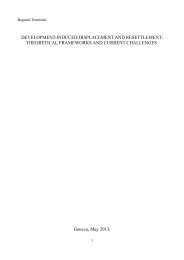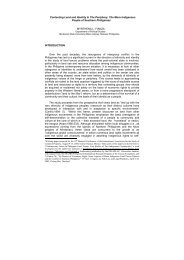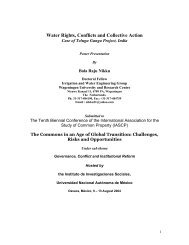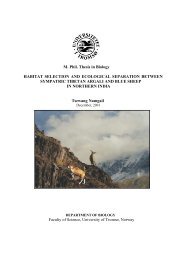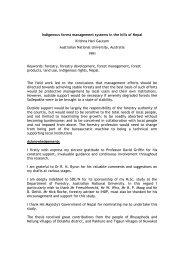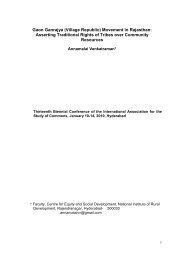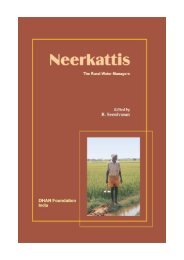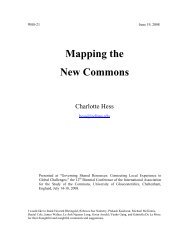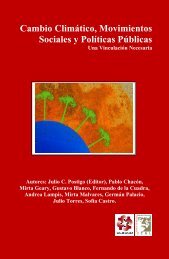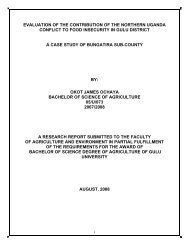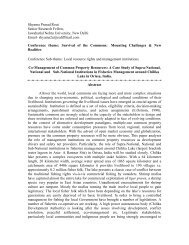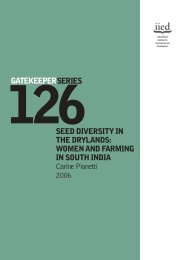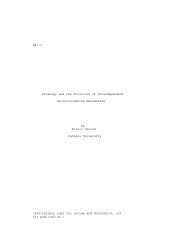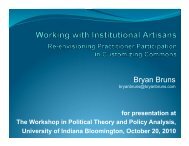• Succession:: Territories and sites are held by hereditary or culturally bestowed rightand passed on through <strong>the</strong> predominant hereditary system or, in some cases, as a gift,in settlement of a debt or to erase a transgression. Whatever <strong>the</strong> case, ownership andrights to control were formally and ceremonially passed on or awarded. Usually titlewas reinforced during recurring cultural ceremonies like <strong>the</strong> potlatch, where allpresent became witnesses of <strong>the</strong> formal change or renewed claim to ownership.• Obligations and Responsibilities: Owners at every level of <strong>the</strong> system wereresponsible for care and perpetuation of all resources under <strong>the</strong>ir jurisdiction,including <strong>the</strong> people living and working <strong>the</strong>re, who were free to move to o<strong>the</strong>r kinshiplocales where <strong>the</strong>y might live better. Such obligations often meant that heirs wentthrough long term training for <strong>the</strong> position, learning history, diplomacy andstewardship traditions that went with <strong>the</strong> territory. Maintenance of ownership systemsrequired adherence to <strong>the</strong> above points as well as an understanding that punishmentfor any transgression was well known and might be severe.In fact, it is likely that <strong>the</strong>se models are more widely representative; as pointed out byBerkes (1999), similar systems for land tenure linked with traditional use andmanagement were in place throughout North America as well as among indigenouspeoples in o<strong>the</strong>r parts of <strong>the</strong> world.Relationships Between Ownership and Resource ManagementFrom <strong>the</strong> beginning of <strong>the</strong>ir first contacts, early European visitors to <strong>the</strong> Northwest Coastreported large populations of aboriginal peoples in <strong>the</strong> communities <strong>the</strong>y visited.Tragically, successive waves of smallpox, influenza, measles and o<strong>the</strong>r diseases unknownin this area at <strong>the</strong> time, swept through aboriginal nations, killing large portions of <strong>the</strong>populace, and often, according to anecdotal archival reports, all but decimating entirecommunities (Boyd 1990). And, as we review historical records from those earlier days,reconsidering previous studies that discounted <strong>the</strong>se reports as <strong>the</strong> inflated exaggerationsof field personnel or simply dismissed as hysterical over-reaction to events (Daniels1992), we are now understanding that human populations were much greater thanpreviously believed.If we consider that in British Columbia, aboriginal population estimates have grown toanthropologist Robert Boyd’s conservative calculation of 100,000-plus (1990) orhistorical geographer Cole Harris’ suggested 200,000 to 400,000, both referring to <strong>the</strong>coastal area alone, <strong>the</strong> environmental impact implications are immense. What effectwould <strong>the</strong> supplying of food, clothing, shelter and medicinal products for that manypeople have on natural systems? What would be <strong>the</strong> extent of cultivated areas for bulbs,rhizomes and o<strong>the</strong>r root foods? How many hundreds of burn-managed sites would berequired to provide adequate berry fruits, green shoots, and medicinal herbs, or to attractgrazers and browsers enabling efficient hunting strategies? Where does all <strong>the</strong> proteincome from to maintain <strong>the</strong>se masses? As we have lately learned, mismanagement and <strong>the</strong>imprudence of over-harvesting can soon devastate resources. Clearly, extensive and18
successful systems of resource management were necessary in order that each culturalgroup could survive and expand its population to <strong>the</strong> high densities suggested.Indigenous peoples saw and, generally, continue to see <strong>the</strong>mselves as related to allelements of <strong>the</strong>ir environment, merely a part of, not above or outside of, something thato<strong>the</strong>rs call "Nature". <strong>The</strong> universality of this indigenous peoples’ perspective isfascinating in itself, considering <strong>the</strong>ir world-wide distribution and geographic and culturaldiversity. For example, First Nation’s "creation" stories often carry intuitive lessons thatteach respect for living things. Living within this ethic and knowing no o<strong>the</strong>r, helpsexplain First Peoples’ widely held spiritual belief that humans were set down in thisworld as its caretakers or stewards. Although most stewardship practices of <strong>the</strong> past arepresently obscure due to losses of so many knowledge holders during <strong>the</strong> epidemics and<strong>the</strong> acculturation policies of colonization that followed, it seems likely that stewardshipsystems and practices were crafted over long periods of time, creating an adjusted,human-influenced ecological balance, woven of survival, spirituality and culture. Webelieve that it was on this spiritually intuitive, respectful, human maintained-balance thatFirst Nations cultures, toge<strong>the</strong>r with <strong>the</strong>ir individual systems of ownership andstewardship, survived and flourished.Survival and reproduction are basic natural imperatives for any organism, includinghumans. Whe<strong>the</strong>r or not we flourish depends on how effective we are, as individuals andas organized groups or communities, at staying alive and healthy. It was commonlyassumed that even though <strong>the</strong> Northwest Coast of North America was known to be one of<strong>the</strong> continent’s most densely populated areas in precontact times, aboriginal populationswere, none<strong>the</strong>less, still too sparse to have any effect on <strong>the</strong> anadromous fish populationson which <strong>the</strong>y largely depended for survival. Presumably, <strong>the</strong> bounty of <strong>the</strong> sea, bycomparison with <strong>the</strong> size of First Peoples’ communities, was infinite and luckyaboriginals simply helped <strong>the</strong>mselves when hungry.On <strong>the</strong> Northwest Coast, as in most places, however, food resources are not evenlydistributed throughout <strong>the</strong> year. Starvation is a frequent <strong>the</strong>me in coastal folk traditions(Boyd 1990:136), well documented in <strong>the</strong> ethnographic recordings of such stories andlegends (see Boas 1932; McIlwraith 1948; Suttles 1968; Maud 1982; Cruickshank 1990).Careful use of limited resources (“never waste anything” seems to be a universal preceptamong indigenous peoples) extends <strong>the</strong> number of people that can be provisioned, andlearning to steward resources successfully, allows <strong>the</strong> population to expand fur<strong>the</strong>r.Consequently, a population’s size was limited by its peoples’ ability to take advantage ofand promote abundance of harvested food resources. It was also regulated by <strong>the</strong>ir abilityto provide for regular times of scarcity such as late winter, for depletions due tounexpected environmental impacts, or for extended periods of stormy wea<strong>the</strong>r (also atime of scarcity), which prevent seasonal harvesting, hunting, or access to those marinefoods, normally available under settled conditions. Accordingly, food storage technology,sharing and redistribution strategies (not just to groups temporarily in need, but also <strong>the</strong>exchange of certain resources that occur in some places but not o<strong>the</strong>rs), probably weremajor factors promoting population stability. Under this perspective, population sizemay be <strong>the</strong> best measurement of how well aboriginal groups were able to adapt to localconditions and enhance natural abundance within <strong>the</strong>ir territorial jurisdiction.19
- Page 2 and 3: settlement. Notably, the template f
- Page 4 and 5: Indigenous Group(Language Family);R
- Page 6 and 7: Sekani, Dakelh or Carrier,Tsilhqot
- Page 8 and 9: families," and the use by others re
- Page 10 and 11: ask permission to use the traps fro
- Page 12 and 13: ... in the case of a salmon stream,
- Page 14 and 15: As well as gardens, patches and sta
- Page 16 and 17: Charles Newcombe (1902: Haida - Ksa
- Page 20 and 21: The burgeoning field of traditional
- Page 22 and 23: longest time", which became the fou
- Page 24 and 25: Barnett, Homer G. 1955. The Coast S
- Page 26 and 27: Hamori-Torok, Charles. 1990. Haisla
- Page 28 and 29: Richardson, Allan. 1976. The Contro
- Page 30: email to Nives Dolsak and Elinor Os



